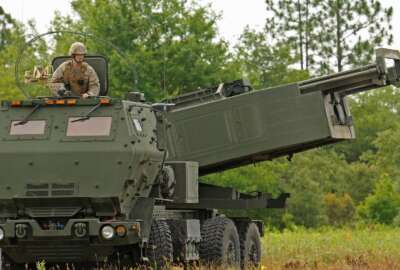
Does the Marines new modernization plan go too far? One of its former commandants thinks so
The U.S. Marine Corps is currently embarking on a restructuring plan know as Force Design 2030. It looks to reshape its combat power for future conflicts with...
The U.S. Marine Corps is currently embarking on a restructuring plan know as Force Design 2030. It looks to reshape its combat power for future conflicts with near-peer adversaries, i.e. China. It also looks to put a bit more reliance on technological advances by divesting in the sorts of protective measures it used to rely on for maintaining operational readiness. Some though feel the plan goes too with these updates could potentially lead to the U.S. losing the upper hand on the international stage. One of them is retired Marine general and former Commandant of the Marine Corps Charles Krulak, who spoke with Federal Drive with Tom Temin about his concerns.
Interview transcript:
Charles Krulak Let me start by saying this is not just me, I represent a group. Our group is made up of every living retired four star general in the Marine Corps. This includes every living commandant, assistant commandant and combatant commander. It includes two former chairman of the Joint Chiefs of Staff, a former secretary of the Navy, and a former Secretary of Defense. So let me tell you what the concerns are, which will lay out the force design 2030. Our concerns are simply put. We’re concerned about the divestment of combat capability within the Marine Corps that our nation has always counted on. In the past three years, the Marine Corps has divested 21% of its infantry, 100% of its tanks, 100% of its bridging capability, nearly 100% of its mine clearing and mine breaching capability. 67% of its Canon artillery, 100% of its law enforcement battalions, and some 29% of its fixed wing fighter attack aircraft and rear wing helicopter aircraft. And that doesn’t count the significant amount of logistics capability that was also divested.
Charles Krulak Now, what was the rationale for these draconian cuts, which only gets to your question. It’s to build a force, force design 2030, that’s going to sit on islands within the first island chain off of China and wait for the Chinese navy ships to sortie, and then take them under missile fire if and when they come into range. I’m sure your listeners will understand that these forces, which are named standing forces, will be targeted immediately by the Chinese as they move to their island positions and as they remain on their island positions. They have a lot of electronics gear with them that’s going to put out an electrical electronic signature. They have heat signatures are going to be produced. So the Chinese intelligence gathering capability is equal to ours. And I will tell you, as soon as the first round is fired, the standard force will be taken themselves under heavy and extremely accurate enemy missile fire. Equally disturbing to all of the people that I mentioned earlier, is that divestment of current capability has occurred while still experimenting with new capability. As an example, the missiles that we’re trying to get, the command, control and communications capability, all of those are being experimented with and they will not be available in the quality, but more importantly, the quantity necessary. Think of the ammunition, the missiles, the quantity necessary for another seven to 10 years. That gap in time is a risk to our national security. As budget increases, the capability of all the forces decrease. And in the case of the Marine Corps, it’s a self-inflicted wound.
Eric White So it sounds like an oversimplification of your argument. And I stress the oversimplification part, is that you seem to take the stance that the best defense is a good offense, or at least the threat of a good offense. And that may be where the change in the in the philosophy of, hey, the future of warfare is long range weapons and a more defensive posture. But you are saying that the Marine Corps should go with what has worked in the past rather than move forward and evolve into this new realm? Or are you saying that they’re just modernizing in a way that is forgetting what the lessons learned of the past.
Charles Krulak Well, you’ve hit a really key point. The fact of the matter is, we the Corps now are more focused on a defensive posture. That’s pretty obvious, and I don’t think anybody would disagree with that. We’ve been painted with the brush, that we’re just a bunch of old fogies who want to return to the good old days that we don’t understand the impact of new technology on warfare, that we don’t recognize that the character of war has changed, that we don’t know the latest intelligence. They’re averse to innovation and new thinking. All of that is pure nonsense, and to many of us it’s insulting. We’ve seen the impact of drones, lawyer munitions, improved CQ capabilities. We understand, as we did when we were on active duty, that the character of war changes, absolutely. At the same time, we know from experience that the nature of war does not change. It is brutal, it’s bloody, it’s cruel to the extreme and unforgiving and mistakes. And it’s now being played out in living color in Ukraine. To think that all of a sudden warfare is going to be fought a 150 kilometer distance, if there’s not going to be any close in fighting that we’re going to be able to cyber our way across a river crossing, or use deceptive means to cross a minefield. It’s just crazy. We understand we are all for capitalizing on technology. What we’re not in favor of is divesting of capability before the new capability gets here. And the thought that somehow war is going to be antiseptic. This is not Ender’s Game. We’re not playing Ender’s Game. We’re playing real world and it is tough. And to think that is going to be solve, I mean, how does a drone work in the jungle? How does a loitering munition work in the jungle? How does drones work in a sandstorm out in the desert? I mean, there are just so many improbable thoughts that you can fight, that the actual care to war is going to change.
Eric White And so my other question is, in this age where mostly, we’re in sort of a new era that’s not like the Cold War, but where the posturing really is the name of the game nowadays. And it’s just about sending messages. Could that be factoring into the military decisions that are being made from above, saying, if we show that we’re ready for a theoretical war with China, somebody who we have differences with, but hasn’t escalated to that level yet, is there a fear of escalation to the point where they’re trying to match us and we’re just kind of butting heads against each other?
Charles Krulak That’s a very good point. And let me address that. First off, we don’t even have the authorization to go on to some of these islands. And the Philippines has made it perfectly clear that they don’t want us there if we’re going to war. The Japanese now are buying missiles and getting ready to help in the defense. If you’re, well, let me back up. If you’re going to look at capability and you’ve got great capability, the Navy with their submarines, they’re out there. The Air Force, with their long range missiles on long range bombers, are out there. The Army with their multidomain task force, which does the same thing as the Marine Corps, is out there. If you are the president of the United States and you get indications of warning, what are you going to do? Well, I’ll tell you, the first thing that will really reinforce that you’re serious, is to take the Marines that are out there and capable, not the ones that are sitting on islands and show the Chinese that you’re reinforcing the Korean Peninsula, you’re reinforcing Japan with the troops that can do what needs to be done. But if you take away their capability, which they’ve done and you heard what they’re taken away. If you take away that capability, the threats not there. Thinking that the Marine Corps sitting on these islands so designated by the Chinese intel capability are going to threaten the Chinese enough to stop them in their tracks, that’s just wishful thinking.
Eric White Got it. And so let’s talk, what is probably been the major hang up nowadays is budgetary concerns, which I’m sure you’ve dealt with in your day and also with your current push for Congress to fund these sorts of measures that you’re suggesting. So how do you maintain a budget that makes way for innovation and research, but also keeps these baseline things that you and your group are concerned about?
Charles Krulak Well, first and foremost, the way the current Marine Corps went about it gained a lot of attention. It was like a shiny new penny that sounded great, that looked like it solved a strategic problem, and by the way, it costs nothing, because he was divesting before he got the capability. So the Congress is sitting there saying, well, we don’t have to fund anything, because he’s divested of this. And so when it comes time and when it’s fully developed, we can buy in the quantity that’s necessary. That all sounds great, except that there’s a time frame that places the nation at risk in doing that. What do you do with the decreasing budget that we see decreasing? Even though the budget increases, we all know that the dollar doesn’t get as much now. You have to understand that you pick and choose, you prioritize within your defense budget, which I did as a commandant. Here’s the priority, I know I’m not going to get it all, but here’s my priority. And you set it up there. You don’t, you do not divest until you have that capability. Best example I can give you, is what you now know is the V-22, the World War aircraft. The Marine Corps had something called the CH-46 helicopter, I was the commandant. That bird was ancient. We kept every one of them until the first squadron of the V-22 came into the inventory, I then got rid of a squadron of CH-46. You do the like for like, if you wanted to get missiles or you wanted to do something with artillery, you wait till you get the new artillery in, whether it’s [Multiple Launch Rocket System (MLRS)] or whatever, before you get rid of your cannon artillery. I mean, it just doesn’t make any sense. So the bottom line is that’s going to give the Congress of the United States a plan that they can either accept or veto. In this instance, they didn’t really understand the plan, because the commandant is saying, I’m going to pay for this all myself. I’m going to do it by divesting. The problem is he divested before he had the capability to get the new equipment in. That’s a threat to this nation.
Copyright © 2025 Federal News Network. All rights reserved. This website is not intended for users located within the European Economic Area.
Tom Temin is host of the Federal Drive and has been providing insight on federal technology and management issues for more than 30 years.
Follow @tteminWFED
Related Stories






